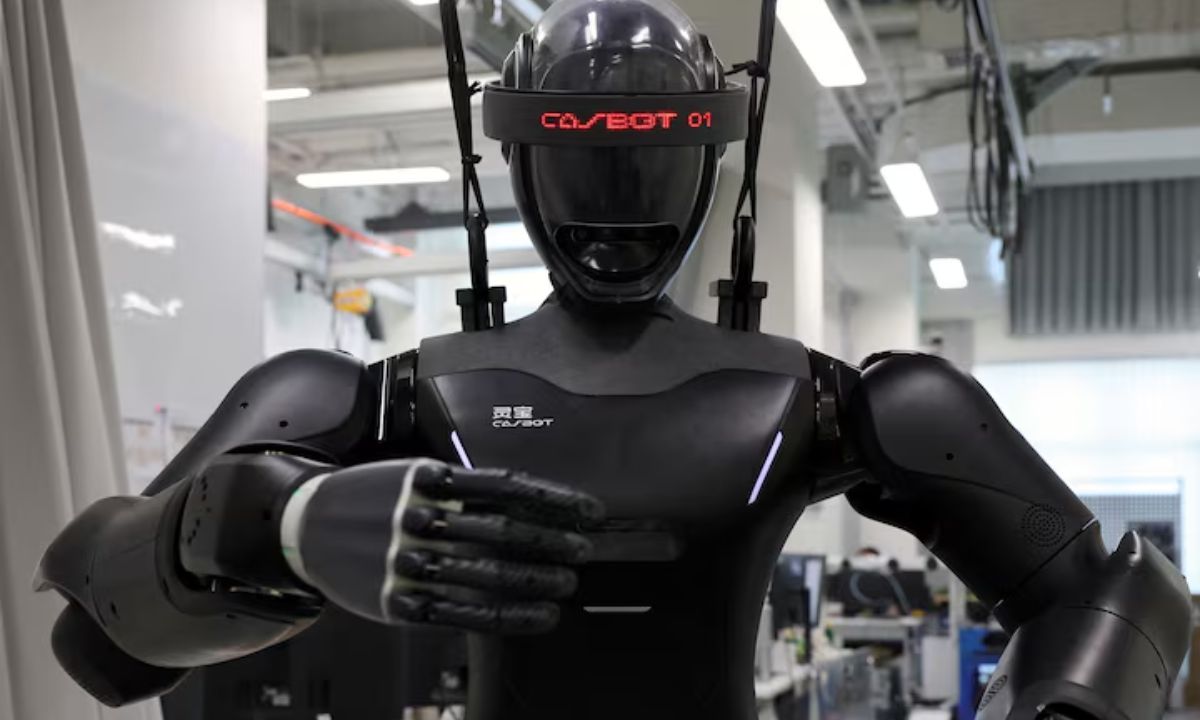China is pushing the limits of artificial intelligence by developing humanoid robots that could change how we work and live. With strong government support and advancements in AI, these robots may soon become part of everyday factory life.
AgiBot’s Robot Lab: Training the Future Workforce
In a massive warehouse outside Shanghai, dozens of humanoid robots are being trained to perform everyday tasks like folding clothes and making sandwiches. They operate 17 hours a day to collect data that helps improve their learning.
Yao Maoqing from the startup AgiBot shared a bold vision: one day, these robots could even build themselves in factories.

President Xi Supports Robotics Revolution
China‘s interest in humanoid robots goes all the way to the top. President Xi Jinping recently visited AgiBot’s facility and joked that the robots might even play football someday. His visit shows just how important this technology is to China’s future economy.
Xi also met with another robotics company, Unitree, encouraging private firms to boost growth through innovation and automation.
U.S.-China Competition Shifts to Robotics
As the U.S. tries to bring back manufacturing jobs through tariffs, China is taking a different path. It’s investing heavily in robots to create what many are calling the next industrial revolution. Humanoid robots are at the center of this plan.
These robots have already shown impressive physical abilities — running, jumping, and even playing sports.

The Real Power: Combining AI with Robotics
What’s making China stand out is how it’s combining hardware with smart AI software. Homegrown tech firms like DeepSeek are leading the way, providing the intelligence behind these humanoid machines.
Experts say this combination will turn robots from interesting machines into useful workers capable of learning on the job.
Robots Ready to Learn and Work
Dozens of insiders told Reuters that China’s next big leap is making robots that can learn by themselves — called autodidact robots. These could take on complex roles in manufacturing, cutting costs and boosting productivity.
The focus now is on training robots using task-specific data — such as how to stack boxes or pour liquids. This kind of training allows them to operate in the real world.

Big Government Investments Fuel Rapid Growth
The Chinese government is providing huge financial support to humanoid robot makers. Over $20 billion was spent last year, and a new ¥1 trillion (about $137 billion) fund is in the works to support AI and robotics.
State-run programs are also offering subsidies, free office space, and production support. In cities like Shenzhen and Wuhan, companies receive up to ¥5 million in aid if they meet production targets.
In 2024 alone, government orders for humanoid robots jumped from just ¥4.7 million in 2023 to ¥214 million.
Falling Costs Could Spark a Robot Boom
Just like electric vehicles, the cost of humanoid robots is expected to drop fast. Today, building one costs around $35,000, but this could fall to $17,000 by 2030, especially if most parts are made in China.
Compared to Tesla’s Optimus robot, which costs $50,000–$60,000, Chinese companies have a big advantage thanks to their local supply chains.
Analysts from Bank of America believe that global sales could hit 1 million units per year by 2030.

Data Is Key to Smarter Robots
Collecting quality data is one of the biggest challenges in building intelligent robots. Unlike chatbots that learn from the internet, humanoid robots need hands-on data from real-life tasks.
That’s why AgiBot’s Shanghai facility — provided rent-free by the government — is so important. It lets hundreds of workers train robots on practical jobs every day.
New data centers like this are being built in cities such as Beijing and Shenzhen, boosting the country’s ability to lead in “embodied AI.”
Startups Like MagicLab Target Real-World Uses
Startups are already putting robots into action. A company called MagicLab has started using robots for quality checks and material handling on production lines. These machines run on advanced AI developed in partnership with DeepSeek, Alibaba, and ByteDance.
CEO Wu Changzheng said 2025 will be focused on expanding into real industries with practical uses.
China Dominates the Humanoid Hardware Industry
One of China’s biggest strengths is its control over robot parts. It can produce up to 90% of the components needed to build humanoids, reducing production costs and speeding up development.
As a result, China now leads the world in robot manufacturing. In 2024 alone, 31 Chinese firms launched 36 different humanoid robot models, compared to just eight from U.S. companies.
Mass Production Begins in 2025
Big names like Unitree and UBTech have either begun mass production or are preparing to start in 2025. Some startups are selling humanoid robots for as low as ¥88,000 (about $12,178).
According to Zhang Miao, COO of CASBOT, China’s efficient supply chain makes it easier to get parts delivered within a day — something that’s hard to achieve in other countries.

Job Security Concerns on the Rise
While these advancements are exciting, they raise questions about job loss. With around 123 million people working in manufacturing in China, the arrival of robots could change the employment landscape.
Lawmakers are beginning to explore ideas like AI unemployment insurance to manage the potential risks.




